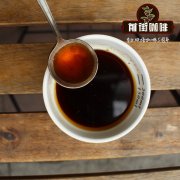Understanding what is coffee defective beans classification of defective beans how to select defective beans

Professional coffee knowledge exchange more coffee bean information please follow the coffee workshop (Wechat official account cafe_style)
A brief discussion on the definition of "Coffee defective beans" by the American Fine Coffee Association (SCAA)
Basically, after the seeds produced by healthy coffee trees are removed, they are washed, sunburned, fermented, dried and shelled. The whole post-processing process is flawless. The color of coffee beans should be blue-green, light green or yellowish green, which are healthy and delicious colors. If there are other harmful colors or spots, it is a warning of defective beans. Because the precursor aromatic components of defective beans-protein, sucrose, fat, trigonelline and organic acids-are oxidized or eroded by molds and fungi, the color of the beans is strange, so since the chemical composition has deteriorated, the color and smell of the coffee will not be good. Drinking it may be harmful to your health.
Coffee production from cultivation, fertilization, irrigation, picking, peeling, fermentation, drying, shelling, transportation and other post-processing to storage, are all variables, the slightest carelessness will deteriorate into defective beans. According to the statistics of the International Coffee Organization (ICO), on average, about 15% to 20% of defective beans are produced in the world-black beans, fermented beans, moldy beans, moth-eaten beans, wilted beans, unripe beans, shell beans, shell beans, broken beans, floating beans, etc., which will cause animal flavor, rotten fruit, bleached water, iodine, sour, potato, fishy, rotten wood and miscellaneous bitterness in coffee, and may contain biotoxins. It's bad for your health.
According to the statistics of the International Coffee Organization (ICO), there are about 1.5 million metric tons of defective beans worldwide in a year. Defective beans will be consumed by the producing countries or transferred to low-cost formula beans to make comprehensive coffee beans or sold cheaply to instant coffee factories to make three-in-one coffee and so on. Miscellaneous bitterness, muddy taste, salty taste and sour taste are the total taste of defective beans, which is difficult to swallow. A cup of coffee with a black bean or sour bean is enough to destroy a good cup of coffee. Only defective beans can meet the standards of Clean cup, and the "regional flavor" of fine coffee can be revealed. Dirty defective beans are the biggest killer of boutique coffee.
The requirements of SCAA for fine coffee are as follows: 1. There are no Class I defects in 350 g raw bean samples; 2. Deduction points of no more than 5 II defects in 350 g raw bean samples.
3. There should not be any "quaker" in 100g coffee cooked beans.
4. The color range of raw coffee beans is pale yellow (light yellow), yellow-green (yellow green), greenish (partial green), green (green), bluish-green (bluish green) blue-green (blue green).
Before selecting defective beans, raw beans need to be screened in order to make the beans uniform in size. You can use three different sizes of special custom screen, or you can use the metal screen sold in general horticultural shops, but pay attention to the size. The purpose of sieving is to separate the size of beans and remove impurities.
Important Notice :
前街咖啡 FrontStreet Coffee has moved to new addredd:
FrontStreet Coffee Address: 315,Donghua East Road,GuangZhou
Tel:020 38364473
- Prev

Coffee what's the difference between single coffee, Italian coffee, premium coffee?
Professional coffee knowledge exchange more coffee bean information please follow the coffee workshop (Wechat official account cafe_style) individual coffee: generally refers to this single style coffee beans from a single country or producing region. It can be compared to a coffee solo. If a bag of coffee is marked with the name of a coffee producing country (coffee beans are not produced in continental Europe, if the name of a city in an European country is written on the label
- Next

What do you mean by the dry and wet fragrance in the coffee? How to taste the aroma of coffee
Professional coffee knowledge exchange more coffee bean information please pay attention to the coffee workshop (Wechat official account cafe_style) dry fragrance: refers to the coffee powder ground into a powder aroma wet fragrance: refers to coffee powder after the addition of hot water after the aroma is not added any brewing variables, simply smell the aroma changes some flavor is obvious when dry fragrance, but after adding hot water, it will be different
Related
- How did the Salvadoran coffee industry develop in Central America?
- What exactly does the golden cup extraction of coffee mean?
- The Origin of Coffee flower
- [2023 Starbucks World Earth Day] there are more meaningful things besides free Starbucks coffee!
- What kind of coffee is there in Spain? 9 Flavors of Spanish Coffee
- Aromatic African coffee| Kenya's coffee culture and historical production area
- Liberica Coffee Bean knowledge: the characteristics of Liberian Coffee beans of the three original species of Coffee beans
- The origin and formula of Spanish latte introduces the taste characteristics of Bombon coffee in Valencia, Spain.
- How to adjust the solution of over-extracted coffee
- What is the tasting period of coffee beans? What is the period of coffee and beans? How should coffee wake up and raise beans?

